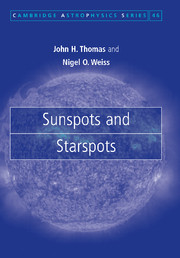Book contents
- Frontmatter
- Contents
- Preface
- 1 The Sun among the stars
- 2 Sunspots and starspots: a historical introduction
- 3 Overall structure of a sunspot
- 4 Fine structure of the umbra
- 5 Fine structure of the penumbra
- 6 Oscillations in sunspots
- 7 Sunspots and active regions
- 8 Magnetic activity in stars
- 9 Starspots
- 10 Solar and stellar activity cycles
- 11 Solar and stellar dynamos
- 12 Solar activity, space weather and climate change
- 13 The way ahead
- Appendix 1 Observing techniques for sunspots
- Appendix 2 Essentials of magnetohydrodynamic theory
- References
- Index
3 - Overall structure of a sunspot
Published online by Cambridge University Press: 28 October 2009
- Frontmatter
- Contents
- Preface
- 1 The Sun among the stars
- 2 Sunspots and starspots: a historical introduction
- 3 Overall structure of a sunspot
- 4 Fine structure of the umbra
- 5 Fine structure of the penumbra
- 6 Oscillations in sunspots
- 7 Sunspots and active regions
- 8 Magnetic activity in stars
- 9 Starspots
- 10 Solar and stellar activity cycles
- 11 Solar and stellar dynamos
- 12 Solar activity, space weather and climate change
- 13 The way ahead
- Appendix 1 Observing techniques for sunspots
- Appendix 2 Essentials of magnetohydrodynamic theory
- References
- Index
Summary
In this chapter we describe the gross features of sunspots, including their shapes and sizes and their overall thermal and magnetic structure. We also discuss those models of a sunspot that ignore its fine structure and make the simplifying assumption that the spot can be treated as an axisymmetric magnetic flux tube. This is a reasonable approximation, for although most spots are irregularly shaped, as can be seen from Figure 1.2, there are still many examples that are approximately circular, like that in Figure 3.1.
Sunspots are dark because they contain strong magnetic fields that partially inhibit the normal transport of energy by convection at, or just below, the solar photosphere. A welldeveloped spot may have a radius of 10,000–20,000 km, with a dark central nucleus (the umbra), surrounded by a less dark, filamentary penumbra. Such sunspots have approximately similar structures. The umbra occupies about 18% of the area of the spot, corresponding to an umbral radius that is about 40% of that of the spot. The umbra radiates energy at only 20% of the normal photospheric rate, corresponding to a temperature deficit of 2000 K, while the average penumbral intensity is about 75% of that outside the spot, corresponding to a deficit of only 400 K (Bray and Loughhead 1964; Thomas and Weiss 1992a; Stix 2002), so the total ‘missing energy’ is about 35% of that from a corresponding field-free area.
- Type
- Chapter
- Information
- Sunspots and Starspots , pp. 38 - 67Publisher: Cambridge University PressPrint publication year: 2008

